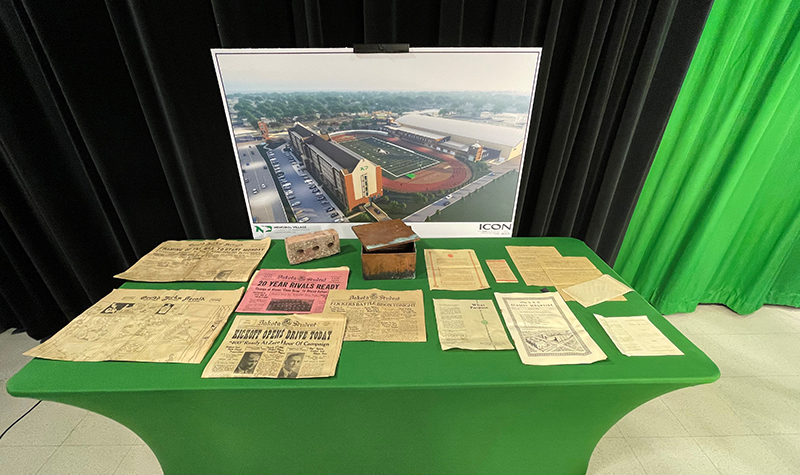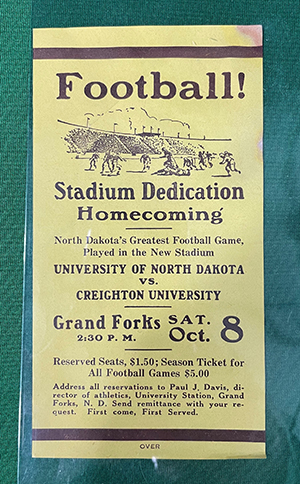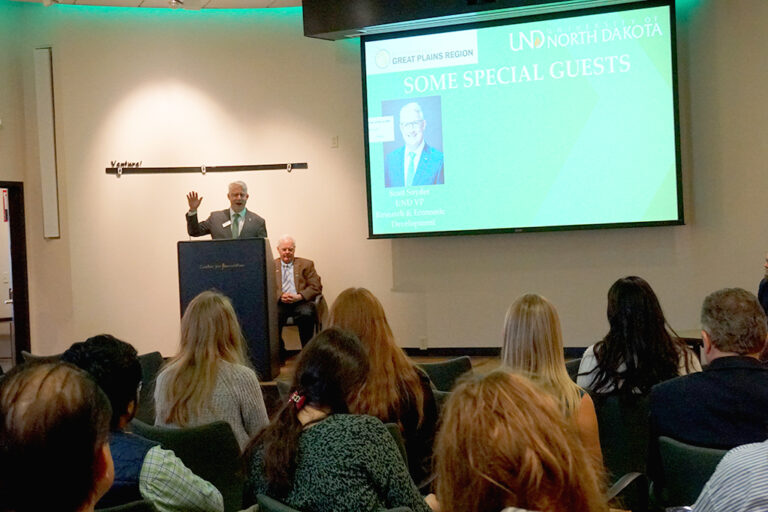A Memorial for the ultimate Memorial
UND officials – past and present – reflect on history and importance of the University’s nearly century-old sports stadium
“A fortress with presence and authority” on the eastern edge of the University of North Dakota campus – that’s an apt description for old Memorial Stadium.
Most importantly, though, Memorial Stadium is and has been just that – a memorial to UND’s third president Webster Merrifield and to 33 UND alumni who marched off to World War I but never returned.
In 1927, when the then-new stadium was dedicated, University and community leaders spoke in bold terms of a structure that might stand the tests of time and last forever.
But almost a century later, the still-majestic structure is giving way to decades of wear. University crews have been monitoring wall movement along the stadium’s western-facing side for about a decade. The external brick layer has “veered out” nearly six inches in parts. Recently, protective tape was placed on the stadium’s west-side parking lot to keep people and vehicles away from falling debris.
The last UND football game in the stadium was played 22 years ago, before the indoor confines of Alerus Center became home field in 2000. The turf field is still used for practices, but the coaches’ offices and other facilities inside the old stadium are near-empty shells, with only remnants from past grid-iron ghosts and the 72 seasons of glory that were played there.
Recently, UND got approvals to begin razing Memorial Stadium and to prepare the grounds for future developments. The demolition work could begin as soon as next week, as UND looks to minimize disruptions to the Campus Community and surrounding neighborhoods by starting the project before other planned work starts on campus.
Starting sooner also could save some money for UND by avoiding the busy road construction season when competition for contractors cranks up.

Time to remember
But before work begins in earnest, UND took time on Tuesday, March 9, to fondly look back on the Stadium, its legacy, its Athletics history and what it ultimately stood for as a memorial. During the 30-minute live-streamed recognition ceremony that was hosted by UND President Andrew Armacost and featured current and past football coaches, the University pulled out the stops to make the event as poignant and meaningful as the venerable old building itself.
The ceremony honored UND’s military fallen of World War I, for whom the stadium was dedicated. They included Congressional Medal of Honor recipient Lt. Col. Fred E. Smith of Grand Forks. The tribute was done with full military honors being rendered by current members of the Fighting Hawks Army Reserve Officer Training Corps Battalion, who lowered the stadium’s flag to the sound of Taps – the same ritual that had honored the fallen almost 95 years ago, on the day of the stadium’s first-ever football game.
UND President Andrew Armacost, who recently retired as a brigadier general after 30 years in the U.S. Air Force, said it’s important not to lose sight of the original intent of Memorial Stadium as being a monument to those alumni who gave the ultimate sacrifice.

There was also a bit of surprise, as President Armacost announced that work crews had recently discovered a copper, shoebox-sized time capsule nestled inside the stadium’s northwest cornerstone, which bears the engraved dedication date of 1927.
The contents of the capsule were revealed toward the end of the ceremony. They included vintage copies of The Dakota Student, The Grand Forks Herald and Alumni Review, various stadium fund-raising promotions and an actual ticket to the dedication and first game played at Memorial Stadium, on Homecoming Saturday, Oct. 8, 1927 — against Creighton University.

Visions for the future
Tuesday’s program wasn’t all about fond farewells. There also were visions for the future, and what could be on the way.
There were images in the background of facility concepts that are proposed for the area, including a five-story “P3” (Private-Public-Partnership) development on the spot now occupied by Memorial Stadium. This development would have a main floor dedicated to offices for UND Athletics staff and coaches, who now call the Hyslop Sports Center home.
Conceptual plans also call for a student-athletes academic center and an Athletics hall of honor area. The top floors would be apartments, owned and operated by a private developer.
Also planned is an addition to the Pollard Center (the existing High Performance Center) to the east across the turf field. The Pollard Center addition would be part of a fund-raising effort by the UND Alumni Association & Foundation to provide locker rooms, weight room facilities and an area for the UND Sports Medicine Department.
The P3 development and Pollard Center addition would be connected by an enclosed glass walkway or “Hawkway.” It would incorporate and follow the path of the stadium’s iconic brick wall, which arcs around the north side of the stadium grounds.
A separate project would eventually replace the field turf and surrounding running track.
Step back in time
UND Alumni Association CEO DeAnna Carlson Zink used her portion of the program to step back to a time when the stadium was still a dream. The mid-1920s was an era of great transformation at UND, which was only a little more than 40 years old at the time.
Under the guidance of then-President Thomas Kane, the new athletics stadium and nearby gymnasium were part of a grand vision to keep pace with the other great Midwestern universities of the day.
Fundraising was more experiment than science in those days. In fact, the stadium/gymnasium effort is said to have been the first of its kind at UND. Beginning in 1925, people such as Paul Samuelson, an alumnus from Bowman, N.D., and Jack Stewart from Grafton, N.D., led the ambitious half-million-dollar drive, using the slogan “Help the U that is Helping U.”
Eventually, plans were downsized a bit so that the project focus became the stadium structure and north wall, at a cost of about $200,000. The project was started and completed in 1927, culminating with a big dedication ceremony that closed down Grand Forks businesses and drew people from far and wide, on Oct. 8 of that year.
“This stadium was so much more than the 392,000 bricks used in its construction,” said Carlson Zink. “In addition to a stadium that gave us decades of happy memories, we owe those behind the (fund-raising) campaign a debt of gratitude for another reason. They were the first to see the potential of what could be accomplished when alumni are asked to help support their alma mater.”
No place like home
Memorial Stadium and its grounds became a place of dominance for UND teams over the decades. UND Athletics Director Bill Chaves detailed the eras of success for UND football. He spoke of 20 conference championships and a tremendous home record over 72 seasons, with 247 wins, only 88 defeats and nine ties.
Chaves also alluded to plans to incorporate elements of the old stadium and the history of UND Athletics into the future developments that are built in the location.
“It’s comforting to know that the grounds that Memorial sat on will be occupied by generations of UND student-athletes for years to come,” Chaves said. “Our heritage will always be commemorated, as today’s Athletics Department could not be what it is without all of the contributions from those who came before us.”
Another highlight was the parade of coaches who participated in Tuesday’s ceremony, and the stories they recounted about the years they’d spent in Memorial Stadium. The coaches included current leader Kyle “Bubba” Schweigert, and former leaders such as Chris Mussman, Roger Thomas and Dale Lennon.
‘That desk’
They recalled the massive old wooden desk in the head coach’s office that all of them used – not necessarily because they wanted to.
“That desk,” Schweigert said incredulously before pausing. “(That desk) has been there a long time. I have to believe that the office was built around it.”
Mussman, thinking back to times he and others tried to budge it before finally giving up, called it the UND version of the “Resolute Desk,” the famed piece of presidential furniture in the Oval Office.
The coaches also talked about reunions with the so-called “Stadium Rats,” former student-athletes from the 1940s through the 60s, who slept, ate and studied in dorm rooms inside the stadium structure.
“Just to see those guys get back together and share the memories about this special place was pretty awesome,” Schweigert said.
Lennon – a UND alumnus and student-athlete who would later lead UND football to its only national championship – was never a Stadium Rat, but the special connections for him are no less intimate when he reflects back upon Memorial Stadium.
“I think of home – Memorial Stadium was home for me for a very long time,” he said. “There was just something about walking into that stadium that made you feel like you were a part of something bigger than yourself.”



